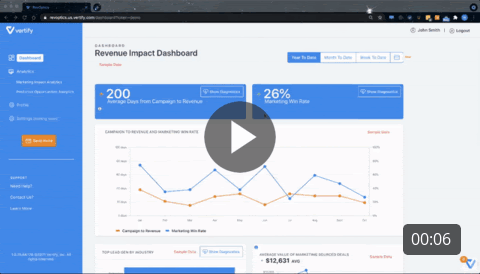Why Do You Need Data Diagnostics?

Data Diagnostics: A True Story
Before digging into a true data diagnostics story, let’s quickly define what it is. Based on Gartner’s Glossary, and considering the term is a synonym for diagnostics analytics: “Diagnostic analytics is a form of advanced analytics that examines data or content to answer the question, ‘Why did it happen?’ It is characterized by techniques such as drill-down, data discovery, data mining, and correlations.”
Imagine any company’s revenue team. Data is the basis for many of the decisions they make every day. This marketing, sales, or traffic data comes from varied sources:
- Sales opportunity data from a Customer Relationship Management (CRM) system
- Marketing campaign data from a Marketing Automation Platform
- Website traffic information from a Website Analytics platform
- Sales engagement information from a Sales Enablement tool
- Billing information from a payment system
The current list could go on endlessly, and the reality most companies face is that this list keeps growing each year. Several tools promise they can bring all this data together into their platform for a “Single Source of Truth” or SSOT.
This sounds like a fantastic solution for data pieces living separately in all these systems, which generate loads of more data each day. This SSOT enables companies to report across systems by first bringing all of the data together and translating it into a single format. Such functionality helps revenue teams create the perfect picture of their future, current, and past customer interactions.
Now, this company needs to layer a business intelligence tool on top. It could help them visualize and glean some value from all this information they have pulled from dozens of systems. After all, what good is the SSOT if they can’t make the data actionable to ensure they are backing their business decisions with actual data from real customers?
After layering on a business intelligence tool to visualize all this data with the help of their data engineering team, our example company wants to know if the pretty chart showing the marketing win rate for the quarter is accurate.

What if some of those Closed/Won opportunities didn’t have a lead source? How would they know if 42 of the Closed/Won opportunities from last quarter came from an activity where marketing had an influence?
The sales funnel looks excellent, with a healthy mix from top to bottom, but does it give insight into where deals might be “stuck” in the funnel relative to their average time in a particular stage? What about firmographic data? Does our fictitious company have an issue with fill rate on a given data point that could help activate more of their marketing database?
So many questions, but at this point, you are likely identifying your own pains in this true story. If so, keep reading.
Related: RevOps: 3 Steps to Take in the New Role
The Importance of Data Diagnostics in a Single Source of Truth
The Digital Marketing Institute provides a few good insights to explore the SSOT concept more in-depth, which will be helpful to continue revealing the importance of data diagnostics:
- The SSOT is helpful to compare channel performance across different digital platforms. Because these apps estimate metrics differently, you need to have a standardized set of numbers to compare channel performance.
- SSOT data can be compared with other data sources to optimize activities according to your truth. By defining a unified data goal, you will avoid working with various data sources to measure actions differently.
- For example, you can gain a complete picture of a channel’s value and how it contributes to your overall business goals by using a web analytics tool like Google Analytics as an SSOT for conversion metrics. It is crucial to also test the variance between Google Analytics and the other SSOT if conversion data is reported truthfully in another platform, like a CRM.
- One way to determine how much data to expect from Google Analytics is to divide it by the other data you have reported and then compare the magnitudes of those results. Depending on the channel, month, or dimensions, it may be necessary to stress test the multiplier and find a reasonable compromise.
Companies spend loads of money each year on tools to help them achieve connections between revenue apps. They then translate the data into a single source so they can visualize the data from all of these disparate systems, only to find out they don’t have all of the data they need because a particular data point isn’t all that well populated.
This is where the importance of data diagnostics finally comes in. It can mean a few different things depending on what you are looking at, but let’s explore the top two angles of data diagnostics.
Related: Top 5 Marketing Analytics Metrics
Missing data
Missing data comes in two forms.
- Data can be missing because it is not in your SSOT.
- Missing data can also happen by simply not collecting it at the source system.
The first scenario is relatively easy to solve by ensuring the source system collects the data, like your CRM or MAP to your SSOT.
The second is missing because one or multiple systems didn’t collect the data point in the first place. It requires either changes in your data practices or working with a top vendor to help you fill in these missing data points, such as the industry or revenue range for accounts in your CRM.
Inaccurate data
Inaccurate data comes in a few different forms, caused by a variety of factors.
The first form is data you have, but you know it is inaccurate. This is the easiest form to solve. Working with a leading data partner to correct these data challenges is usually a great option.
The second form of a data inaccuracy challenge is one of the hardest ones to fix: Data you believe to be accurate but is, in fact, not. This can happen for many different reasons which may depend on data entry or data decay.
Now that there’s a level set on some of the data challenges you may be facing, let’s get into how data diagnostics, tied in with your analytics solution, can solve these complex issues.
How Can Data Diagnostics Give You The Data Behind The Metrics?
As a revenue operations pro, you may frequently have questions like these in mind:
- How many Closed/Won opportunities are missing lead sources, preventing us from seeing a complete picture of our marketing impact on revenue?
- How about missing firmographics?
- What are our top industries on leads created in the last quarter?
- How many of those leads are missing Industry information to report on our top-performing industries lately?
Data diagnostics can help you identify all of these challenges plus others to ensure you are truly getting the whole picture, not just what you see on the surface of your revenue analytics tools. Proper data diagnostics will allow you to make data-driven decisions confidently, knowing the metric isn’t skewed or misrepresented in some fashion.
Reporting with confidence matters in your data-driven, fast-paced B2B revenue environment. Diagnostics are imperative to give you an added layer of trust in your reporting and data management practices. If you assume your data is clean and the pretty charts are accurate, you may be losing critical findings to make smarter decisions.
You need data diagnostics-leveraged assurance, and RevOptics can provide you with the best in the industry. Get intelligent data automation solutions to create marketing and sales alignment across every application and stage of the buying process. Request a demo now.
